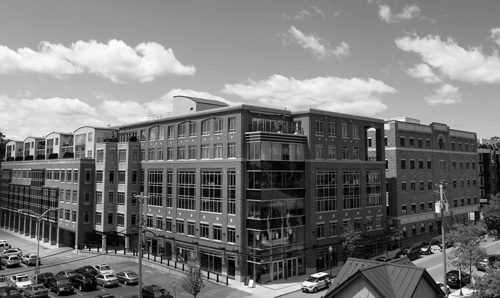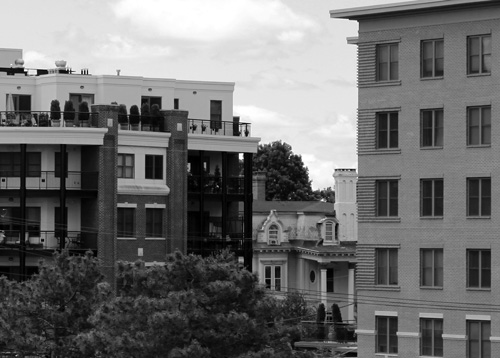News
Wellspring of success?
In downtown Saratoga Springs, a construction boom goes on
By THOMAS DIMOPOULOS
Contributing writer
SARATOGA SPRINGS, N.Y.

Long before the Saratoga battles of the Revolutionary War, before the grand hotels of the Victorian era or the opening of the horse-racing track that would draw thousands of visitors to the region every summer, the 28 square miles that would become the city of Saratoga Springs first attracted visitors for the naturally carbonated water that bubbled from underground and was said to have medicinal powers.
City Historian Mary Ann Fitzgerald, who grew up on the West Side in the 1940s and ‘50s and has witnessed the city’s evolution through bust and boom in the decades since, says the subtle secret of Saratoga Springs’ success literally runs through it.
“Why does Saratoga Springs prosper?” Fitzgerald asked. “I think there is one thing that brings us back to our center. We have the mineral springs that emanate from the earth. It is subliminal: We are aware they’re there, but we’re not thinking how they affect us. Even in difficult times, somehow it helps to keep us focused. We are here because of the health-giving springs that date back to the Native Americans and runs all through our history.
“That’s what makes us different. No one else has that. … I know if I need to take a break, I don’t have to get in my car and drive 100 miles. And when people visit, they’re always very intrigued by the springs – whether they like the taste or not.”
It was the springs that gave the city its name and spurred its development as a destination resort, and it was horse racing that kept the visitors coming.
But in the past 10 to 15 years, the city of “health, history and horses” has seen a development boom that likely can’t be explained by its healing springs or racehorses alone.
Along Broadway and the side streets just to its west, a series of new multi-story, mixed-use buildings have sprung up, filling in empty or underused lots. Nearly all of the new buildings provide retail and commercial space on the street level and high-end condominium apartments on the upper floors.
As a result, the number of housing units in the city increased nearly 12 percent between 2000 and 2010, to 12,936, even as its population grew by a far more modest 1.5 percent. The median home value shot up 126 percent in the same period, to more than $290,000, according to U.S. Census figures.
At the same time, the city once known for its grand hotels – most of which were lost to the wrecking ball in the early 20th century – is in the midst of a new explosion of hotel construction. On top of the newly completed Pavilion Grand Hotel, Marriot Courtyard and Hampton Inn, new hotels have been proposed on Congress Street, South Broadway, Lake Avenue and at the rear of Broadway’s 179-year-old Rip Van Dam Hotel. The owners of Saratoga Casino and Raceway also have proposed adding a new hotel and event center alongside the raceway’s video slots parlor.

A Greek revival building from the early 19th century, center, is dwarfed by new high-rise buildings along Division Street and Railroad Place in downtown Saratoga Springs. A series of new mixed-use, multi-story buildings have risen in the past 15 years on formerly vacant or underused lots.
As of late last year, Saratoga Springs had 1,645 hotel rooms -- already a sharp increase from the number 15 years ago -- and plans now are pending for nearly 600 more.
The downtown business district has gotten so busy that city leaders are struggling to keep up with the demand for off-street parking. New multilevel parking garages opened both west and east of Broadway in the past few years, and more are planned. Most notably, the authority that runs the City Center, the downtown convention and exhibition facility, has submitted plans for a $10 million parking garage with spaces for more than 500 cars.
Boom and bust
Next year, Saratoga Springs will celebrate the centennial of its incorporation as a city. Its recent wave of prosperity hearkens back to the boom years of the late 19th century that led it to outgrow its earlier status as a village.
With improvements in railroad transportation in the late 19th and earlier 20th centuries, Saratoga Springs had become a destination. Grand hotels housed summer visitors, and the 5,000-seat Convention Hall was built to host political conventions and other events.
But then came crackdown on gambling in the early 20th century. The Great Depression hit, and within a 25-year period the nation became immersed in two world wars. The Congress Hall Hotel was razed in 1913, the United States Hotel was demolished in 1946, and the Grand Union Hotel met the wrecking ball less than a decade later. The Great Fire of 1957 wiped out a series of stores along Broadway, and in 1965 fire destroyed Convention Hall.
By the 1960s, downtown Saratoga was a veritable ghost town, with nearly two dozen empty storefronts on Broadway and a gap-toothed look resulting from the grand hotels and other buildings that had been demolished or burned. People used to say, only half joking, that if a cannonball were fired down the center of Broadway at noon, it would have hit no one.
Worse, the federal Urban Renewal program was in full swing, giving cities new powers to buy and clear land for redevelopment. The program led to the bulldozing of historic buildings and the disruption of neighborhoods in cities across the nation.
In Saratoga Springs, nearly 250 properties were acquired through Urban Renewal, and a number of historic structures were demolished. For people who grew up on the West Side, there was a huge sense of loss after most of the buildings on Congress Street were torn down.
Saving a downtown
Although the 1960s were arguably one of the bleakest times in the history of Saratoga Springs, some say actions undertaken then laid the groundwork for the upscale retail stores and million-dollar, high-rise apartments that have arisen throughout the city center in the past 15 years. The bumpy road to the 21st century, they say, was navigated by sheer human will.
“One thing led to another, and people made a commitment to surviving,” said Matt McCabe, who in June celebrated his 20th anniversary as owner of the Saratoga Guitar store downtown. He also served as the city’s finance commissioner from 2003-07.
“People just made a commitment,” McCabe said. “They said, ‘We’re not going to die.’”
The Holiday Inn, built downtown in 1964, began serving smaller conventions when there was no larger hall left in the city. Its business model, using community shareholders, served as a catalyst for change, McCabe said.
At the same time, Norman Fox, the founding president of the Saratoga Merchants Association, led a successful battle against an arterial highway that would have bypassed downtown and diverted traffic away from the city.
“Norman Fox and others committed to not letting that happen,” said McCabe, who cites that fight as one of the more important ones in the city’s history. “They made a blood, sweat and tears commitment, and when you have those seeds planted and that kind of entrepreneurial spirit, it laid the financial commitment.”
The city still had its springs and the Saratoga Race Course. To the north of downtown, construction of a new Skidmore College campus began in 1963. Three years later, the Saratoga Performing Arts Center opened at the city’s south end.
And the city had plenty of wonderful old buildings available at bargain prices. Newcomers were able to buy these inexpensively and fix them up.
The multigenerational ties of families also helped steady the city’s course.
“Every day I recognize the names of some of the people whose father started a business here, whose grandfather started a business here, and now they have businesses here,” McCabe said.
Charting a new course
In 1973, local merchants and citizens organized the Saratoga Plan of Action Committee to begin the process of restoring Broadway to its former glory. The activists soon won allies in the city government, and four years later, the city enacted local legislation that created overlay zoning to protect historic properties. The Urban Renewal era was over.
It took many years, but eventually, the destruction left by Urban Renewal literally paved the way for new construction to take place. The City Center, which opened in 1984, was one of the first in a series of projects that began filling the holes in downtown.
“The City Center was very controversial when it was first built,” Mayor Joanne Yepsen said. “There was Urban Renewal, but if you look at the product we ended up with and where we compare with other upstate cities, I think those who have come before us have made good decisions.”
The mayor, a Democrat in her first term, said the city’s planning and zoning efforts in the past two decades have been intended to foster traditional, urban-style development downtown while preserving green space in the city’s outer district.
“All the developments in our last two comprehensive plans have been in the core of downtown,” Yepsen said. “That’s by design. If we had started spreading out like other communities into a suburban sprawl, we would not be the destination location we are today.”
A typical infill project is the new mixed-use building The Washington, which includes Northshire Bookstore on its lower floors and was built on what for years was a parking lot on the east side of Broadway. Similarly, the Park Place condominiums now fill the former Convention Hall site.
Across from Congress Park, a space once filled by the block-long Grand Union Hotel was in more recent decades the site of a dilapidated strip mall. But now it’s home to Congress Park Centre, a multi-story development with Victorian-inspired windows, cornices, a second-floor piazza and national retail chains stores such as Gap and Banana Republic on the ground floor.
“Today, people see a lot of development going up, but there is a certain amount of logic because of our zoning ordinances and Planning Board efforts,” Yepsen said. “There are a lot of checks and balances that occur to ensure people can’t build just anything.”
And just as there have been since the 1970s, there are lots of local people willing to speak up to stop any development they don’t see as being in the city’s long-term interest.
So in November, when voters across New York supported a statewide referendum to allow construction of four full-fledged casinos upstate, Saratoga Springs, which already hosts a video-lottery casino, seemed a likely candidate for one of the new facilities. Gov. Andrew Cuomo had estimated a full-scale casino would yield $5.7 million annually in new revenue for the city.
But Saratoga Springs voters, who rejected the casino referendum by a wide margin, packed City Hall earlier this year to urge the City Council to oppose hosting a full-scale casino. The council abided, unanimously passing a nonbinding resolution opposing the casino, and the owners of Saratoga Casino and Raceway – who had wanted to expand their operation to include table games – decided instead to pursue a site in Rensselaer County.
Public-private partnerships
City officials, the public and business leaders have had their share of clashes with one another over the past several decades, but respectful discourse is healthy and vital to success, said Todd Shimkus, president of the Saratoga County Chamber of Commerce.
“In industrial cities, the public and private sectors don’t always get along,” Shimkus said. “They argue about taxes, about redevelopment, about regulations. Here, going back 40 to 50 years, they have looked at a way to set those differences aside and work together.
“In terms of the community’s success, many of the most significant projects that led to a vibrant community are public partnerships: the City Center, the work to keep Skidmore College here, the efforts to protect racing, Congress Park, and certainly the revitalization of Broadway,” he added.
Shimkus’ office is just west of Broadway, where colorful banners promote local events and large sculptures of horses and ballet shoes dot the sidewalks. Nearby are the corporate headquarters of Saratoga Spring Water; Stewart’s Shops; Quad/Graphics, an offset printer of national magazines; and Ball Corp., a manufacturer of mason jars and aluminum beverage cans.
“I’ve been in other communities — in Massachusetts, and in places that have been struggling as much as places in upstate have,” Shimkus said. “I think about what makes this place so different than others I have seen. I see the projects that have been shared. And I think that’s what is unique.”
Today, new and old literally stand side-by-side. John Morrissey’s 19th century gambling house, Canfield Casino, now serves a history museum and the centerpiece of Congress Park, and City Hall, built in 1871, still functions as the center of local government. Just to the west, Division Street and Railroad Place feature newly constructed high-rise structures anchored by an 11-screen cinema that opened last year.
The cinema complex and its neighbors fill a site where the city’s massive Victorian-era train station once stood; it was demolished in the 1950s and replaced for many years by a low-slung Price Chopper supermarket.
Growing range of attractions
Not all of the new development has been in the center of the city. In recent years, West Avenue has seen the construction of a new $6 million train station, the opening of the YMCA of Saratoga’s $10 million, 75,000-square-foot community and fitness center, and the construction of the Empire State College International Programs building and Center for Distance Learning facility.
“For me, it’s the local pride, the enthusiasm, and the history and careful planning that’s been done in terms of architecture and preservation that is a big reason we’re so successful,” Yepsen said. “In the future, I’d like to see more bike lanes, more walking paths and a connectivity of trails inside the city with all of them leading to downtown. I feel that’s critical. We’re eventually going to run out of parking spots.”
She predicted the city eventually will need to consider setting up shuttle services from outlying park-and-ride lots.
For a city of 27,000 people, Saratoga Springs has lots of amenities, including three museums, two colleges and Saratoga Spa State Park. In Caffe Lena, it has the oldest continuously operating coffeehouse in the country, and in Yaddo, a world-renowned artists’ retreat.
More than 50,000 flowers are planted along Broadway and adjacent streets during citywide beautification campaigns annually, and festivals such as the Victorian Street Walk, Dance Flurry, First Night Saratoga, and Chowderfest ensure wintertime visitors make Saratoga more than just the August place to be.
“We have so many spokes in our wheel, from entertainment to tourism to manufacturing,” McCabe said. “In other places, if you lose one of these things, you might die. Here we could lose a spoke in our wheel and continue going.”
And the summer racing season, though it’s now just one part of a larger package, still remains a huge economic force for Saratoga Springs.
“When you have a racetrack that is running an exclusive in the country in August for the top thoroughbreds in the world, that’s going to help in many ways,” Yepsen said. “It’s going to help keep the quality of life in the city, because we’re going to care what we look like. Visitors are coming in from all over the world. We have a show to put on and a reputation to protect.”

